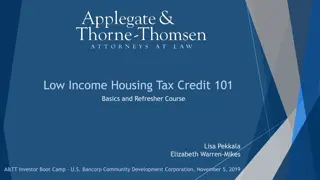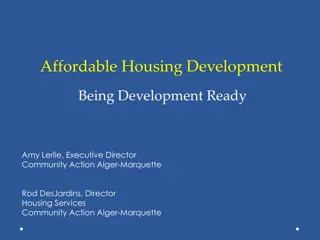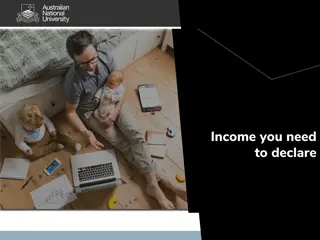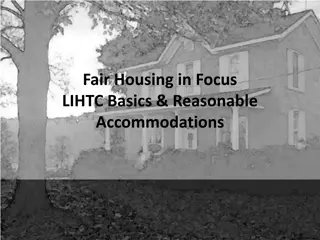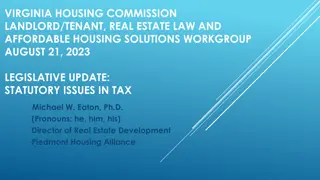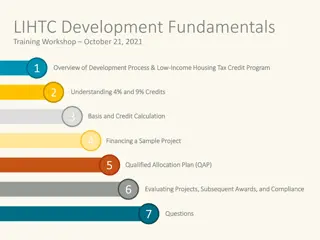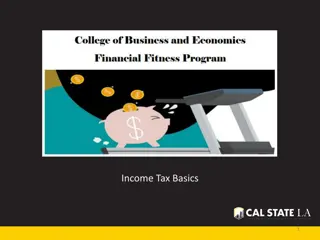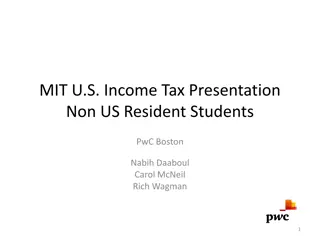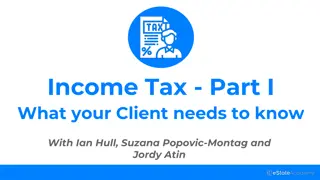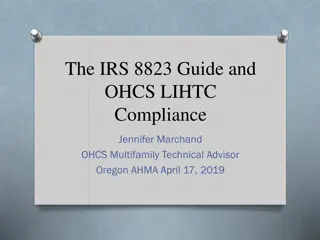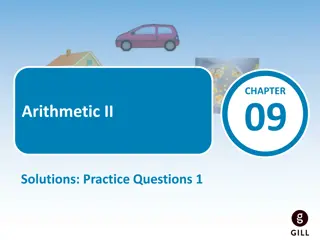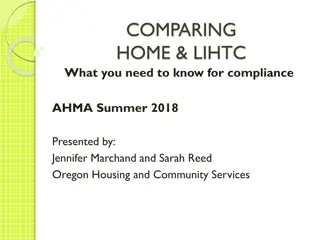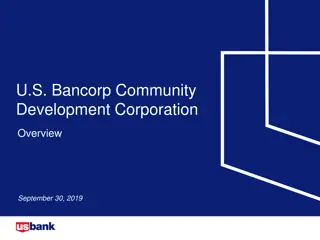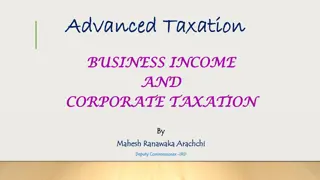Understanding Low Income Housing Tax Credits (LIHTC)
LIHTC is a federal program established in 1986 to promote private investment in affordable housing, providing financing for the construction and renovation of affordable rental units. Developers receive credits which can be used or sold to investors, reducing debt and allowing for lower rents. The credit amount is based on building costs, claimed over 10 years with a 15-year compliance period. Various parties are involved in the transaction, and state housing finance agencies allocate credits based on population.
Download Presentation

Please find below an Image/Link to download the presentation.
The content on the website is provided AS IS for your information and personal use only. It may not be sold, licensed, or shared on other websites without obtaining consent from the author. Download presentation by click this link. If you encounter any issues during the download, it is possible that the publisher has removed the file from their server.
E N D
Presentation Transcript
FINANCING MULTI-FAMILY HOUSING: STRUCTURING THE LOW INCOME HOUSING TAX CREDIT AND TAX EXEMPT BONDS Using Low Income Housing Tax Credits (LIHTC) B Y D E L P H I N E G . C A R N E S D E L P H I N E C A R N E S L A W G R O U P, P L C Charlottesville Redevelopment and Housing Authority December 10, 2020
LIHTC PROGRAM OVERVIEW Established by the Tax Reform Act of 1986 (P.L. 99-514) to encourage private investment in affordable housing. Was made permanent in 1993 Codified in Section 42 of the Internal Revenue Code ( Code ) Goal of the program is to provide financing for the construction and rehabilitation of affordable rental housing Today, the LIHTC program is the main federal financing tool for the production and renovation of affordable rental housing. As of 2019, approximately 3.3 million affordable housing units were created using LIHTC 2
LIHTC PROGRAM OVERVIEW, continued Developers of qualified projects who receive LIHTC in turn use the credits themselves or sell them to investors The investors equity contributions reduce the amount of debt the project would otherwise need With lower debt service payments, the projects can succeed with lower rents 3
LIHTC PROGRAM OVERVIEW, continued Dollar-for-dollar reduction of federal tax liability for the owner of the qualified project Amount of credit based on cost of building new affordable units or renovating existing housing developments Credits claimed over a 10 year period Tax Credit Compliance period is 15 years But the restrictions extend for at least 30 years 4
PARTIES TO THE TRANSACTION Developer State Housing Finance Agency Lender LIHTC investor Residents Consultant, General Contractor, Architect, Engineer, Surveyor, Title Company, Locality, Attorneys, Accountants 5
ALLOCATION PROCESS While it is a federal credit, the program is administered by state housing finance agencies States receive tax credits based on population, therefore the amount of available 9% credits is limited. The State allocation limits do not apply to 4% LIHTC. State agencies allocate credits to developers. Selection priorities and procedures vary in each state and are outlined in a Qualified Allocation Plan ( QAP ) 6
QUALIFIED ALLOCATION PLANS (QAP) State housing finance agencies must adopt QAP to allocate credits QAP must set forth priorities that govern allocation QAP must identify a procedure for notifying IRS of non- compliance Projects financed with tax-exempt bonds must satisfy QAP 7
PROJECT EVALUATION The types of projects eligible for LIHTC include apartment buildings, duplexes, townhouses and single family dwellings State agency will only allocate amount of credits necessary for the project s feasibility Items to be considered include: Sources and uses of funds Equity to be generated by tax credits Reasonableness of development and operating costs Market study Evaluation occurs at application, allocation and completion of project 8
OWNERSHIP STRUCTURE IN LIHTC TRANSACTIONS Owner of the units is a for-profit entity (limited partnership) Tax credit investor is the limited partner and typically owns 99.99% of the entity (99.99% of tax credits, profits and losses) Investor will invest its equity in the form of multiple capital contributions made according to negotiated benchmarks. General Partner typically owns 0.01% and oversees operations General Partner guarantees construction completion, stabilization, operating deficits, as well as total amount of credits and timing of delivery of credits 9
OWNERSHIP CHART for LIHTC TRANSACTION Limited Partnership 0.01% 99.99% General Partner (Developer) Limited Partner (Investor) 10
INVESTORS Typically, the investors rely on the credits as their primary return on investment. That return varies depending on the price they pay for the tax credits In addition, investors receive tax benefits related to any tax losses generated by the project s operating costs, debt service payments, and depreciation deductions Investors have a primarily passive role in the partnership. The developer, as the general partner, controls the construction of the project and the day-to- day operations The majority of investors are large corporations or financial institutions, some of whom invest through syndicators. Some investors are driven by a need to meet their Community Reinvestment Act (CRA) obligations, while others only look for a favorable rate of return 11
TYPES OF LIHTC The subsidy is realized by claiming the credits each year for 10 years, with the actual credit amount calculated to yield a present value of 70% (with the 9% LIHTC) or 30% (with the 4% LIHTC) of eligible costs 9% LIHTC are the best you can get Finances new construction without additional federal subsidies More equity 70% value But much more competitive because limited amount in each State Must include a minimum amount of rehabilitation per unit ($15,000 currently in Virginia) 12
TYPES OF LIHTC, continued 4% LIHTC with Tax-Exempt Bonds Finances new construction that uses additional federal subsidies or the acquisition and renovation of existing units Less equity 30% value Easier to obtain (bonds are competitive but 4% credits are automatic and not subject to the per capita limit) More complex financing structure Higher closing costs Must include a minimum amount of rehabilitation expenditures to qualify ($15,000 per unit currently in Virginia) 13
LIHTC AND BOND CAPS FOR 2021 In IRS Rev. Proc. 2020-45, the IRS announced an increase in the LIHTC and private activity bond volume caps for 2021: The LIHTC state ceiling for 2021 is $2.81 (the same per capita rate as 2020) multiplied by the state population (8,626,210) for a total of approximately $24,239,650. The minimum for small states has gone up since last year from $3,217,500 to $3,245,625 The amount used to calculate the state ceiling for the issuance of bonds has increased; it will be the greater of $110 multiplied by the state population or $324,995,000. Previously, the state ceiling was the greater of $105 multiplied by the state population or $321,775,000 14
CREDIT CALCULATION The credit earned depends on three variables: the amount spent on the building (eligible basis) the portion of the building devoted to low-income units (qualified basis) the applicable rate (applicable percentage) The credit is calculated building by building Annual credit amount is available each year for 10 years, beginning with the year in which the building is placed in service (unless the taxpayer elects to defer the start of the credit period by one year) The credit is calculated to provide a yield over a 10 year period equal to 70 percent (9% LIHTC) or 30 percent (4% LIHTC), as applicable, of the building s qualified basis In the first year, the credit amount is reduced to reflect qualified occupancy in that year 15
CREDIT CALCULATION, continued ELIGIBLE BASIS Credit based on Eligible Basis, not total development costs. The determination of a building s Eligible Basis is the starting point for the computation of the credit Most costs, minus non-depreciable items (Eligible Basis includes rehabilitation costs, reasonable developer fee, common areas) Examples of non-eligible costs: land, syndication costs, financing costs, legal fees related to the acquisition of land, costs of surveys, federal grants, commercial space 16
CREDIT CALCULATION, continued QUALIFIED BASIS Qualified basis: Eligible basis x applicable fraction The qualified basis of a building is that portion of the building s Eligible Basis that is attributable to low-income tenants (number of low income units compared to total number of units, or floor space fraction) 17
CREDIT CALCULATION, continued APPLICABLE RATE The 9% and 4% credits are adjusted based upon the Applicable Federal Rate (AFR), published by the IRS each month. The floating rate for the 9% credit is currently 7.2% The applicable percentage is set either when the State issues the credit reservation or when the building is placed in service When the 9% LIHTC program was created, the applicable rate was 9%. Since then, rates have declined based on the federal cost of borrowing, thereby reducing the amount of tax credit equity available to build affordable housing Since July 2008, several laws have temporarily fixed the 9% tax credit rate at 9%. In December 2015, Congress passed the Protecting Americans from Tax Hikes ( PATH ) Act of 2015, which permanently sets the minimum 9% tax credit rate at 9% The 4% credit is still subject to adjustment based on the AFR. For December 2020, the rate for the 4% credit is 3.09% 18
CREDIT CALCULATION, continued Eligible basis x percent qualified units x applicable percentage x 10 years = total tax credits Total tax credits x price per credit = investor total equity Note that most of the investor s equity will not be contributed to the owner entity until the project is completed 19
CREDIT CALCULATION, continued Example of Tax Credit Calculation 300 Unit Project/240 Low-Income Units TDC (including land) = $40M Land Cost= $4M Eligible Basis= $36M Qualified Basis= $28.8M ($36M x 80%) Applicable percentage for 9% credit = 9% Annual credit= ($28.8M x 9%)= $2,592,000 Credits over 10 years = $25.92M 20
CREDIT CALCULATION, continued Sample Equity Installment Structure Capital contributions by Investor 5% at closing 75% at 100% completion of project 15% at project s breakeven or stabilization 5% at issuance of Forms 8609 / final cost certification 21
LIHTC PROGRAM REQUIREMENTS Occupancy/Income Requirements Either 20% of units occupied by households with incomes at or below 50% of AMI, adjusted for family size ( 20/50 ) Or 40% of units occupied by households with incomes at or below 60% of AMI, adjusted for family size ( 40/60 ) The set-aside election is made on IRS Form 8609 upon placement in service The requirements of the minimum set-aside must be met no later than the close of the first year of the credit period and must continue throughout the compliance period Tenant income must be reviewed and documented at least annually throughout the compliance period 22
LIHTC PROGRAM REQUIREMENTS, continued Rent Requirements The gross rent (including utilities) for a LIHTC unit may not exceed 30% of the imputed income limit applicable to such unit size Rent limits change annually when new area median incomes are calculated Rent never decreases below original floor Rent subsidies (including Section 8) are not included in calculating gross rent Maintain habitability standards 23
TERM OF AFFORDABILITY RESTRICTIONS The occupancy/income and rent restrictions are in place for the 15 year tax credit compliance period An additional extended use period of at least 15 years applies to most developments pursuant to recorded extended use agreement 24
CARRYOVER ALLOCATIONS 10% of Reasonably Expected Basis must be incurred within one year of the date of allocation Reasonably Expected Basis is the anticipated basis of the land and building at such time as the building is placed in service Building must be placed in service by December 31 of the second year after carryover 25
RECAPTURE 10 year credit period / 15 year compliance period means the credits are accelerated , i.e. claimed faster than they are earned Recapture percentage depends on year in which recapture event occurs. Only the accelerated portion of the credit is recaptured Recapture occurs if there is a decrease in qualified basis Recapture amount calculated based on the decrease in qualified basis / new applicable fraction, plus interest Interest on recapture amounts accumulates from the due date of tax returns on which credits were claimed 26
RECAPTURE EVENTS/CURES Building Disposition Sale to new owner or foreclosure Recapture avoided if it is reasonably expected that building will continue to be operated as low-income building Non-Qualified Units Decrease in the applicable fraction of a building occurs when units no longer qualify Examples: over-income household moves into low-income unit, owner charges above limit rent, low-income units rented to household comprised entirely of full time students, leasing on a transient basis Recapture avoided if owner corrects noncompliance within reasonable time after noncompliance is, or should have been, discovered 27
RECAPTURE EVENTS/CURES, continued Casualty Loss/Damaged Units Fire, flood, hurricane or other damage to building or portion thereof Recapture is avoided if damage is repaired (units restored and placed back in service) prior to year-end in which casualty occurred or damage reported 28
POTENTIAL ROLES FOR PHAs IN A LIHTC TRANSACTION Partnership Structure How much Control for the PHA and how much risk? PHA as General Partner/member of General Partner Developer PHA as developer PHA as co-developer Third party developer PHA as Property Manager 29
PHA GUARANTIES IN A LIHTC TRANSACTION Construction Completion Guaranty Operating Deficit Guaranty Payment Guaranty Tax Credits Recapture/Repurchase Guaranty 30
LIHTC REQUIREMENTS FOR PHAs TO CONSIDER Asset Management and Compliance Experience Reports to Investor Accounting Address this issue early with your staff 31
COMPLIANCE State housing finance agency monitors projects Record keeping requirements: Total number of units and number of LIHTC units in project Income certifications Qualified and eligible basis amounts Rent amounts Annual compliance certifications 32
CONCLUSION LIHTC is a critical tool to help finance affordable housing Tax exempt bonds in 4% transaction add value, but transaction is more complex Potential impact of tax reform Evaluate the project carefully Consider the economic value of the credit and any additional subsidies, compared to the reduced revenue due to lower rents and the administrative burden of ongoing compliance with LIHTC rules (and bond rules for 4% LIHTC) Select good partners 33
ADDITIONAL RESOURCES Low-Income Housing Tax Credit Handbook, Novogradac & Company LLP VHDA Low Income Housing Tax Credit Manual, 2020 Low-Income Housing Tax Credit Handbook, Market Segment Specialization Program (MSSP), http://unclefed.com/surviveIRS/lihc.pdf National Low Income Housing Coalition http://nlihc.org CohnReznick www.Cohnreznick.com/affordablehousing 34
Delphine G. Carnes dcarnes@delphinecarneslaw.com DELPHINE CARNES LAW GROUP, PLC 101 W. Main Street Suite 440 Norfolk, VA 23510 Office: (757) 612-4314 | Cell: (757) 677-6092 www.delphinecarneslaw.com December 10, 2020


